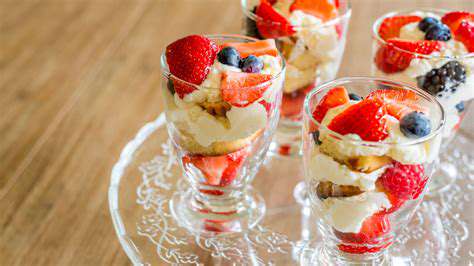Diabetic Friendly Desserts: Sweet Treats without Sugar
Natural sweeteners provide a tasty and wholesome substitute for refined sugar, delivering sweetness without the negative impact on blood sugar levels. These sweeteners come from fruits, vegetables, and other natural sources, making them both sustainable and nutritious. Learning about the various types of natural sweeteners and their effects on blood sugar is essential for creating diabetic-friendly meals.
Discovering natural sweeteners can introduce exciting opportunities for making delightful desserts that don’t compromise health or flavor. Options like stevia and dates each bring unique qualities and advantages. This section explores the benefits and considerations of using natural sweeteners in desserts suitable for those managing diabetes.
Stevia: A Low-Calorie Sweetener
Stevia, extracted from the stevia plant, is prized for its intense sweetness without adding calories. This makes it an excellent choice for those monitoring blood sugar levels. Stevia is generally safe for diabetics and can replace sugar in many recipes, offering a convenient and tasty alternative to traditional sweeteners.
Monk Fruit: A Zero-Calorie Sweetener
Monk fruit extract, sourced from the monk fruit plant, is another calorie-free sweetener with a sweetness level comparable to sugar. Its low glycemic index means it doesn’t significantly affect blood glucose, making it ideal for diabetics. Monk fruit is versatile and can be used in baking and beverages, allowing you to enjoy sweetness without guilt.
Dates: A Natural Sweetener with Nutrients
Dates are naturally sweet and packed with nutrients like fiber, potassium, and antioxidants. Their sweetness makes them a great sugar substitute in desserts. The fiber in dates helps regulate blood sugar, making them particularly beneficial for diabetics. Including dates in desserts offers both flavor and nutrition.
Agave Nectar: A Complex Carbohydrate Sweetener
Agave nectar, derived from the agave plant, is a complex carbohydrate with a lower glycemic index than refined sugar. However, the glycemic index can vary, so it’s important to choose carefully and monitor blood sugar levels when using agave in diabetic-friendly recipes.
Maple Syrup: A Natural Sweetener with Flavor
Maple syrup, made from maple tree sap, adds a rich, distinctive flavor to desserts. It contains minerals like zinc and antioxidants. Despite its high glycemic index, using maple syrup in moderation can still be part of a balanced diet. Combining it with other natural sweeteners can create delicious, healthier desserts.
Delicious Fruit-Based Dessert Ideas

A Refreshing Summer Treat
This light and flavorful dessert is perfect for warm days, blending fresh fruit with a delicate texture for a delightful experience. This recipe is simple to prepare, requiring few ingredients and minimal effort. It’s a great way to highlight seasonal produce and can be customized with different fruits to suit your taste.
Using ripe, in-season fruit ensures the best flavor and texture. This dessert is sure to impress at gatherings or as a personal treat.
A Healthy and Nutritious Choice
This dessert isn’t just tasty—it’s also packed with vitamins, minerals, and antioxidants. Including fresh fruit in your diet supports overall health and wellness. This recipe is a delicious way to increase fruit intake without sacrificing enjoyment. It’s a guilt-free option that caters to various dietary needs.
Easy Preparation and Customization
This dessert is quick to make, ideal for busy schedules. Its simplicity allows for endless variations. Try different fruit combinations or add yogurt for a creamier texture. The versatility of this recipe makes it a go-to for any occasion.
Beyond Traditional Desserts: Innovative Alternatives

Beyond the Expected: Exploring Novel Dessert Concepts
Traditional desserts can feel repetitive. Innovative dessert ideas break the mold, introducing exciting flavors and textures. Experimenting with new concepts can transform your dessert experience.
Modern Interpretations of Classics
Reinventing classic desserts with unique twists, like adding matcha to chocolate cake, can make them feel fresh and exciting. These updates bring new life to familiar favorites.
Fusion Flavors: A Global Culinary Adventure
Combining flavors from different cultures creates unforgettable desserts. Imagine pairing Japanese matcha with French pastry techniques—the possibilities are endless.
Texture and Presentation: Sensory Delight
Desserts should delight all the senses. Unexpected textures, like crunchy brittle with creamy mousse, elevate the experience. Presentation is just as important as taste.
Sustainability and Ethical Sourcing: Conscious Choices
Using local, seasonal ingredients and reducing waste supports both the planet and local communities. These choices make desserts not only delicious but also responsible.
Science and Technology: Pushing the Boundaries
Advances in culinary science open new doors for desserts. From molecular gastronomy to innovative ingredients, the future of desserts is full of potential.
Maintaining a Balanced Diet with Diabetic-Friendly Desserts
Choosing Healthy Alternatives
For diabetics, finding satisfying desserts that fit dietary needs is crucial. Fruit-based options, yogurt parfaits, or baked goods with sugar substitutes can be delicious and blood sugar-friendly. Portion control remains key.
Portion Control and Frequency
Even healthy desserts should be eaten in moderation. Monitoring portion sizes and frequency helps maintain stable blood sugar levels. Plan desserts as part of your meal plan.
The Role of Sugar Substitutes
Sugar substitutes can reduce sugar content in desserts. Consult a healthcare professional to choose the best options for your needs.
Creative Dessert Ideas
Experiment with nuts, seeds, and spices to create diverse, flavorful desserts. Explore diabetic-friendly recipes for inspiration.
Understanding Your Body's Response
Monitor blood sugar after eating desserts to understand their impact. Keeping a food diary helps track responses and informs better choices.